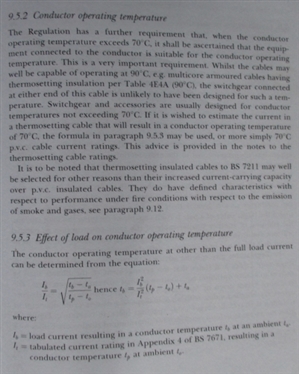Kindly check pages 5 and 6 of attached file and give me your opinion.

AJJewsbury:
You mean Formulas such as Neher-Magrath or that which are found in IEC-60287 or is there another formula in BS-7671.
I usually use ETAP to find actual operating temperatures of cables for Under ground systems but I can't find easy equation for another mode of installations.
I've (to my shame) no idea what the formula is called or where it's originally from. I'm pretty sure it doesn't appear in BS 7671 in this form, although it does have some similarity to equation 6 in appendix 4 of BS 7671 if you strip out all the correction factors.
I've dug it out - this is an extract from the IET's Commentary on the Wiring Regulations, 16th Ed which probably explains it better than I could ever paraphrase. (it's way out of date now of course, but the underlying physics won't have changed I'm sure):
- Andy.
You mean Formulas such as Neher-Magrath or that which are found in IEC-60287 or is there another formula in BS-7671.
I usually use ETAP to find actual operating temperatures of cables for Under ground systems but I can't find easy equation for another mode of installations.


AJJewsbury:
There's a formula relating the derating of a cable to its conductor temperature (I don't have it to hand but should be able to dig it out if needs be) - from memory it's similar to the one for adjusting voltage drop when a cable isn't fully loaded. I'm sure I've seen it used to justify the use of 1.5mm² MICC cable on ring circuits in one of the IET books - showing that the 70 degree terminal temperature isn't exceeded.
You are making a big assumption here - that there is logic behind the cable rating figures.
AJJewsbury:
On the face of it that sounds inconsistent, but I think the difference is accounted for by PVC having a higher thermal insulation value than XLPE
We're about to take you to the IET registration website. Don't worry though, you'll be sent straight back to the community after completing the registration.
Continue to the IET registration site